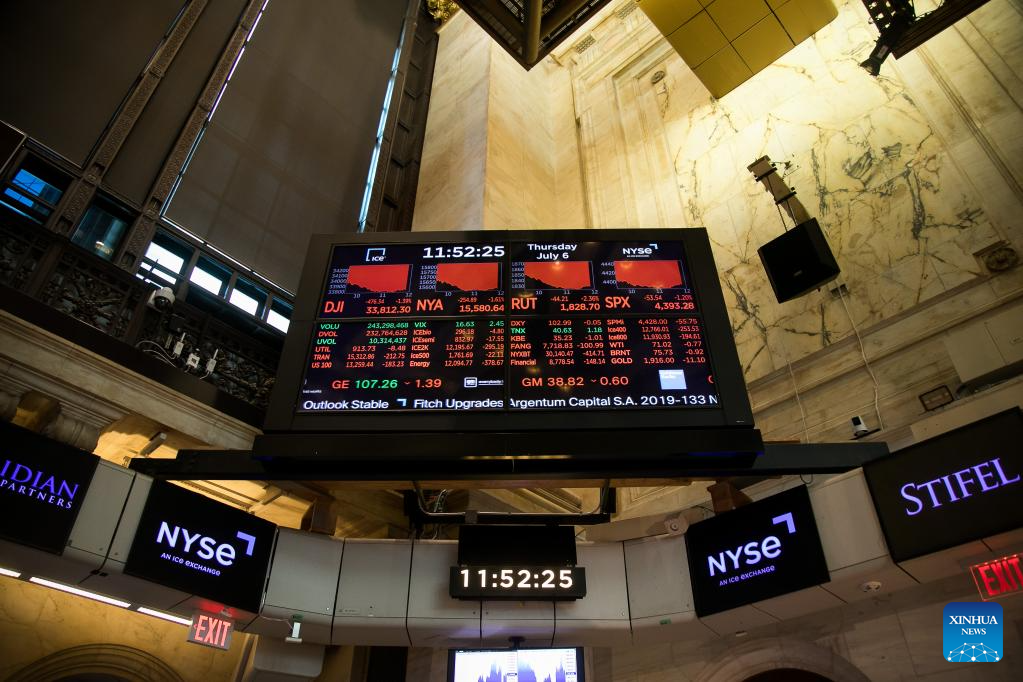
A screen displays stock market information on the floor of the New York Stock Exchange (NYSE) in New York, the United States, on July 6, 2023. U.S. stocks ended lower on Thursday as strong private hiring data fueled bets the Federal Reserve will have to take a more aggressive approach to tame inflation, which sent U.S. Treasury yields higher and weighed on equity markets. The Dow Jones Industrial Average fell 366.38 points, or 1.07 percent, to 33,922.26. The S&P 500 lost 35.23 points, or 0.79 percent, to 4,411.59. The Nasdaq Composite Index declined 112.61 points, or 0.82 percent, to 13,679.04. (Photo by Michael Nagle/Xinhua)
by Gu Xiang
NEW YORK, July 6 (Xinhua) -- U.S. stocks ended lower on Thursday as strong private hiring data fueled bets the Federal Reserve will have to take a more aggressive approach to tame inflation, which sent U.S. Treasury yields higher and weighed on equity markets.
The Dow Jones Industrial Average fell 366.38 points, or 1.07 percent, to 33,922.26. The S&P 500 lost 35.23 points, or 0.79 percent, to 4,411.59. The Nasdaq Composite Index declined 112.61 points, or 0.82 percent, to 13,679.04.
All of the 11 primary S&P 500 sectors ended in red, with energy and consumer discretionary leading the laggards by losing 2.45 percent and 1.65 percent, respectively. Technology posted the weakest decline, down 0.16 percent.
U.S. stocks slid on Thursday after hotter-than-expected jobs data underscored the ongoing strength of the labor market and raised investors' fears of future rate hikes from the Fed.
Private sector jobs increased 497,000 in June, nearly double the number created in May and far surpassing market expectations of 220,000, marking the biggest monthly gain since July 2022, according to data from payroll processing firm ADP.
The strong ADP hiring data sent U.S. Treasury yields rising across the curve in Thursday's session, with the yields on the 2-year and the 10-year notes surging to theirs highest levels since March.
At a time when investors bet that the report would encourage the Fed to be more aggressive, statements from Federal Reserve Bank of Dallas President Lorie Logan added more fuel to their concerns. She said on Thursday that more rate hikes would likely be needed to slow hot inflation.
Federal Reserve policymakers may well be dreading tomorrow's jobs report after today's ADP number once again obliterated estimates, which came in more than doubling the consensus forecast, said Craig Erlam, senior market analyst at OANDA, a supplier of online multi-asset trading services.
"If a rate hike this month wasn't already nailed on, it probably is now. The ADP isn't often a great precursor to the NFP (Nonfarm Payroll) number but this is a report you simply can't ignore. I'm sure everyone will be revising up their expectations on the back of it and wondering just how much longer this labor market resilience can last," according to Erlam.
Investors also digested other jobs data released on Thursday. The U.S. Department of Labor reported that the initial jobless claims rose to 248,000, an uptick of 12,000 from the previous week's revised level of 236,000, which showed a modest increase. Meanwhile, the number of job openings decreased to 9.8 million on the last business day of May, falling below the 10 million mark again, a sign that the tight labor market might be seeing at least some loosening, according to the U.S. Bureau of Labor Statistics.
While the rally in U.S. stocks has stalled this week, the S&P 500 has still gained 15.8 percent so far in 2023. The market is too upbeat about the prospect that the Fed can achieve a soft landing for the U.S. economy, according to an analysis published by UBS Global Wealth Management. "Risks remain that the Fed could hike more than markets are expecting." ■
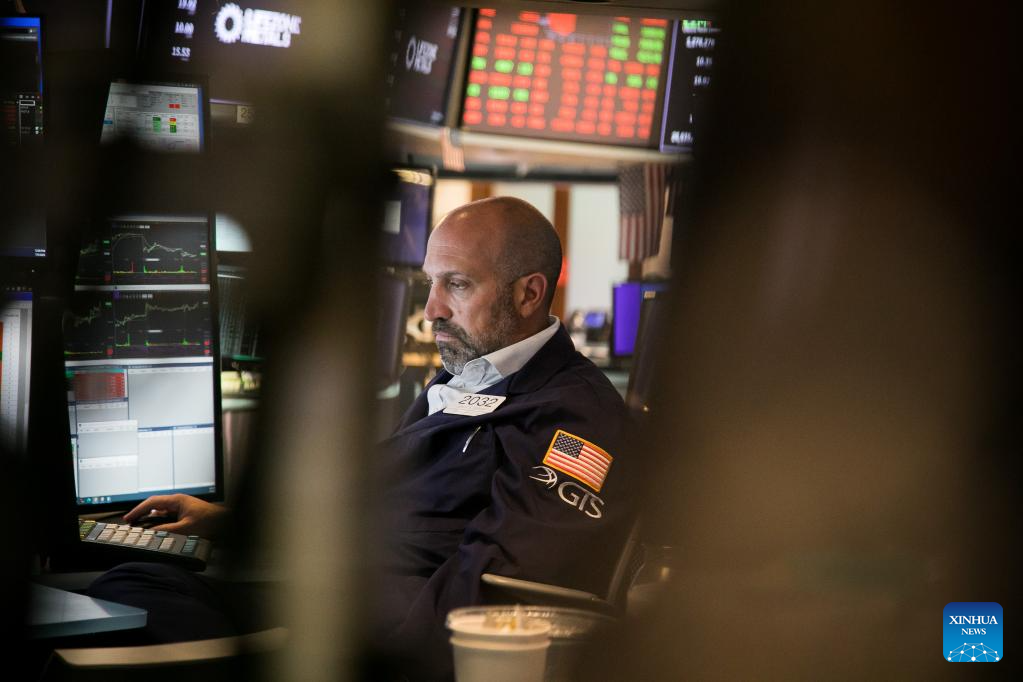
A trader works on the trading floor of the New York Stock Exchange (NYSE) in New York, the United States, on July 6, 2023. U.S. stocks ended lower on Thursday as strong private hiring data fueled bets the Federal Reserve will have to take a more aggressive approach to tame inflation, which sent U.S. Treasury yields higher and weighed on equity markets. The Dow Jones Industrial Average fell 366.38 points, or 1.07 percent, to 33,922.26. The S&P 500 lost 35.23 points, or 0.79 percent, to 4,411.59. The Nasdaq Composite Index declined 112.61 points, or 0.82 percent, to 13,679.04. (Photo by Michael Nagle/Xinhua)
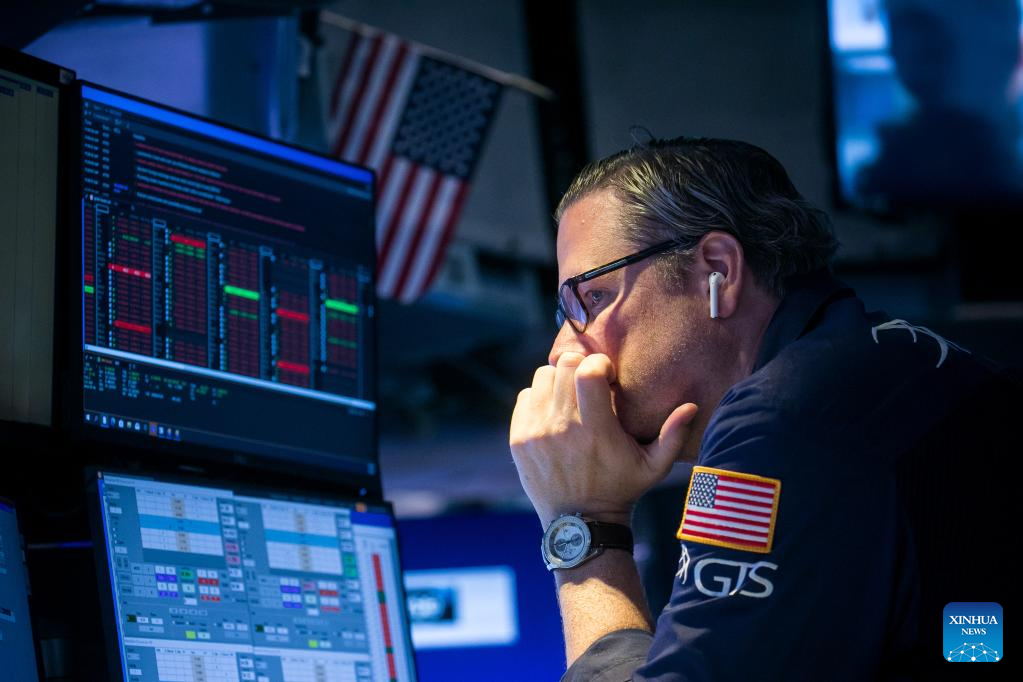
A trader works on the trading floor of the New York Stock Exchange (NYSE) in New York, the United States, on July 6, 2023. U.S. stocks ended lower on Thursday as strong private hiring data fueled bets the Federal Reserve will have to take a more aggressive approach to tame inflation, which sent U.S. Treasury yields higher and weighed on equity markets. The Dow Jones Industrial Average fell 366.38 points, or 1.07 percent, to 33,922.26. The S&P 500 lost 35.23 points, or 0.79 percent, to 4,411.59. The Nasdaq Composite Index declined 112.61 points, or 0.82 percent, to 13,679.04. (Photo by Michael Nagle/Xinhua)
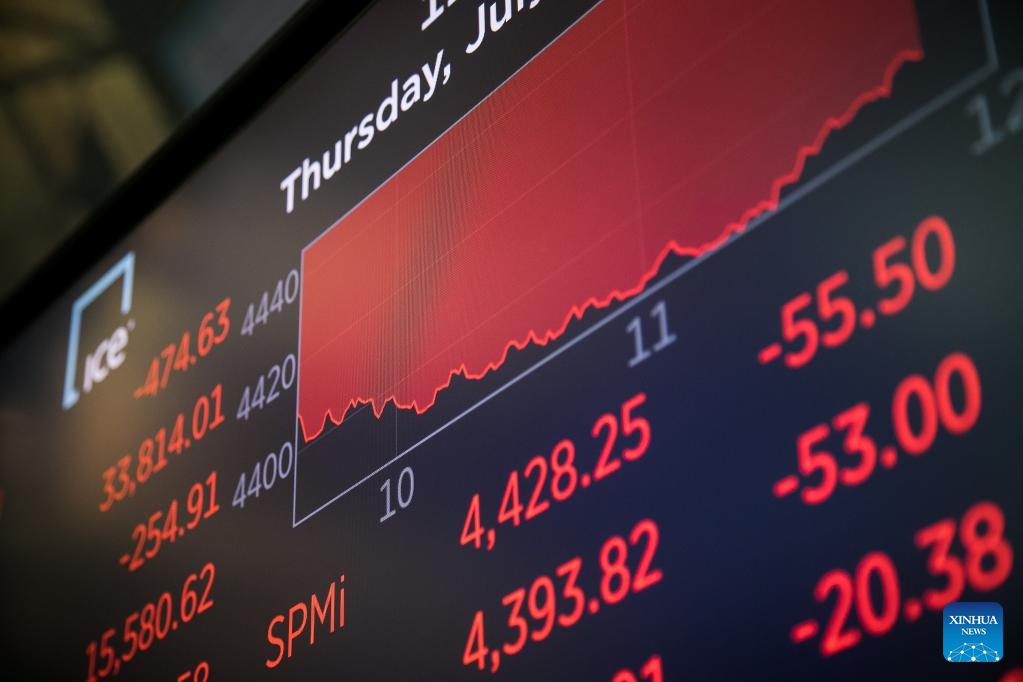
A screen displays stock market information on the floor of the New York Stock Exchange (NYSE) in New York, the United States, on July 6, 2023. U.S. stocks ended lower on Thursday as strong private hiring data fueled bets the Federal Reserve will have to take a more aggressive approach to tame inflation, which sent U.S. Treasury yields higher and weighed on equity markets. The Dow Jones Industrial Average fell 366.38 points, or 1.07 percent, to 33,922.26. The S&P 500 lost 35.23 points, or 0.79 percent, to 4,411.59. The Nasdaq Composite Index declined 112.61 points, or 0.82 percent, to 13,679.04. (Photo by Michael Nagle/Xinhua)
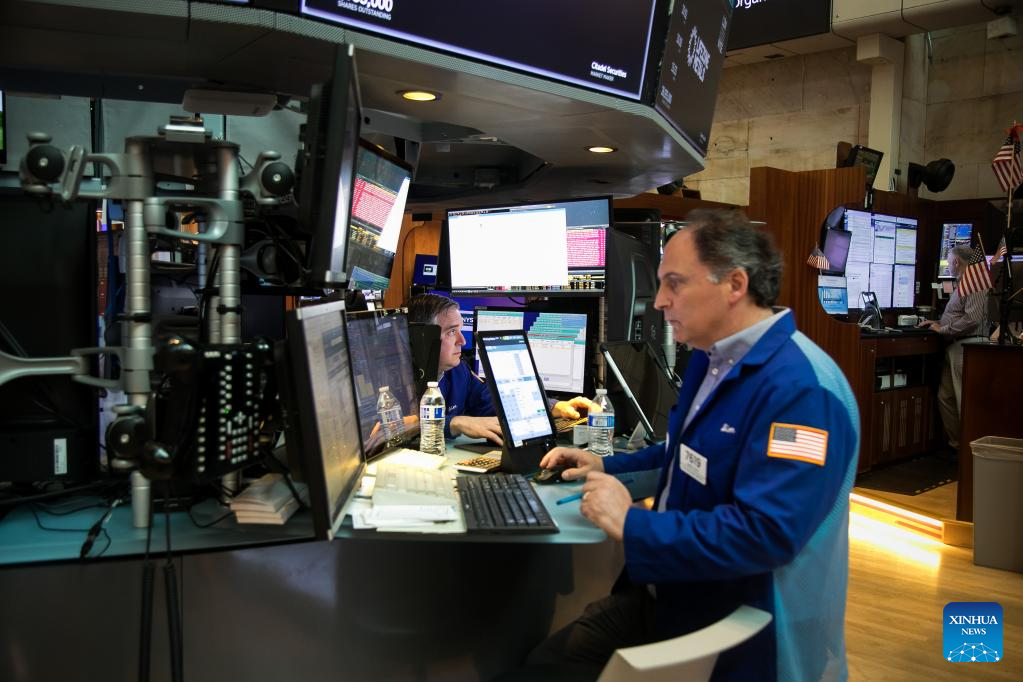
Traders work on the trading floor of the New York Stock Exchange (NYSE) in New York, the United States, on July 6, 2023. U.S. stocks ended lower on Thursday as strong private hiring data fueled bets the Federal Reserve will have to take a more aggressive approach to tame inflation, which sent U.S. Treasury yields higher and weighed on equity markets. The Dow Jones Industrial Average fell 366.38 points, or 1.07 percent, to 33,922.26. The S&P 500 lost 35.23 points, or 0.79 percent, to 4,411.59. The Nasdaq Composite Index declined 112.61 points, or 0.82 percent, to 13,679.04. (Photo by Michael Nagle/Xinhua)
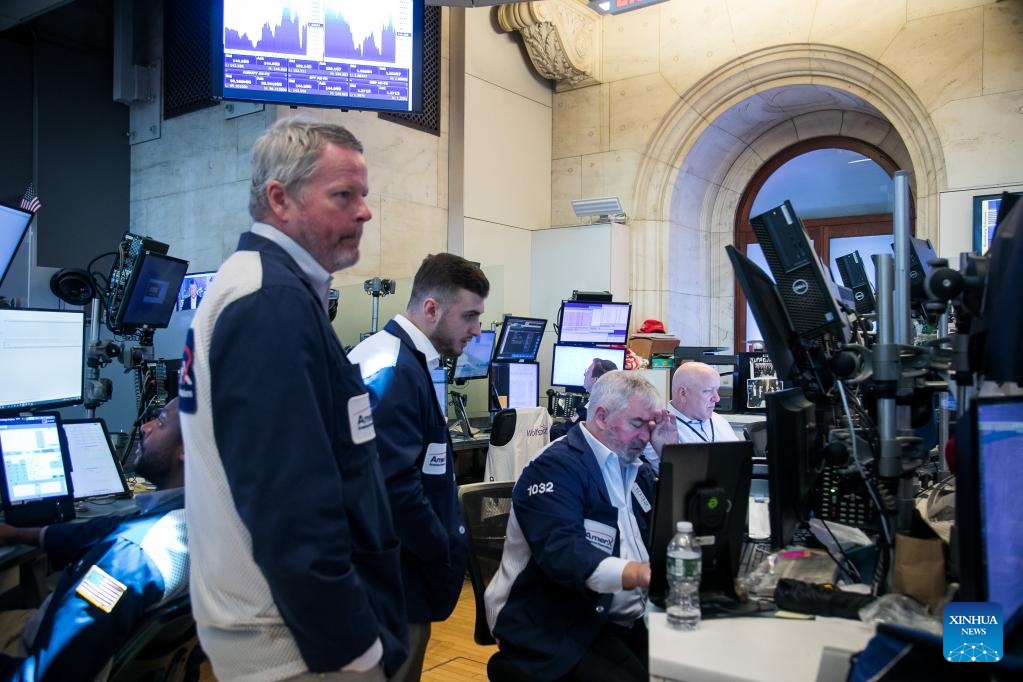
Traders work on the trading floor of the New York Stock Exchange (NYSE) in New York, the United States, on July 6, 2023. U.S. stocks ended lower on Thursday as strong private hiring data fueled bets the Federal Reserve will have to take a more aggressive approach to tame inflation, which sent U.S. Treasury yields higher and weighed on equity markets. The Dow Jones Industrial Average fell 366.38 points, or 1.07 percent, to 33,922.26. The S&P 500 lost 35.23 points, or 0.79 percent, to 4,411.59. The Nasdaq Composite Index declined 112.61 points, or 0.82 percent, to 13,679.04. (Photo by Michael Nagle/Xinhua)
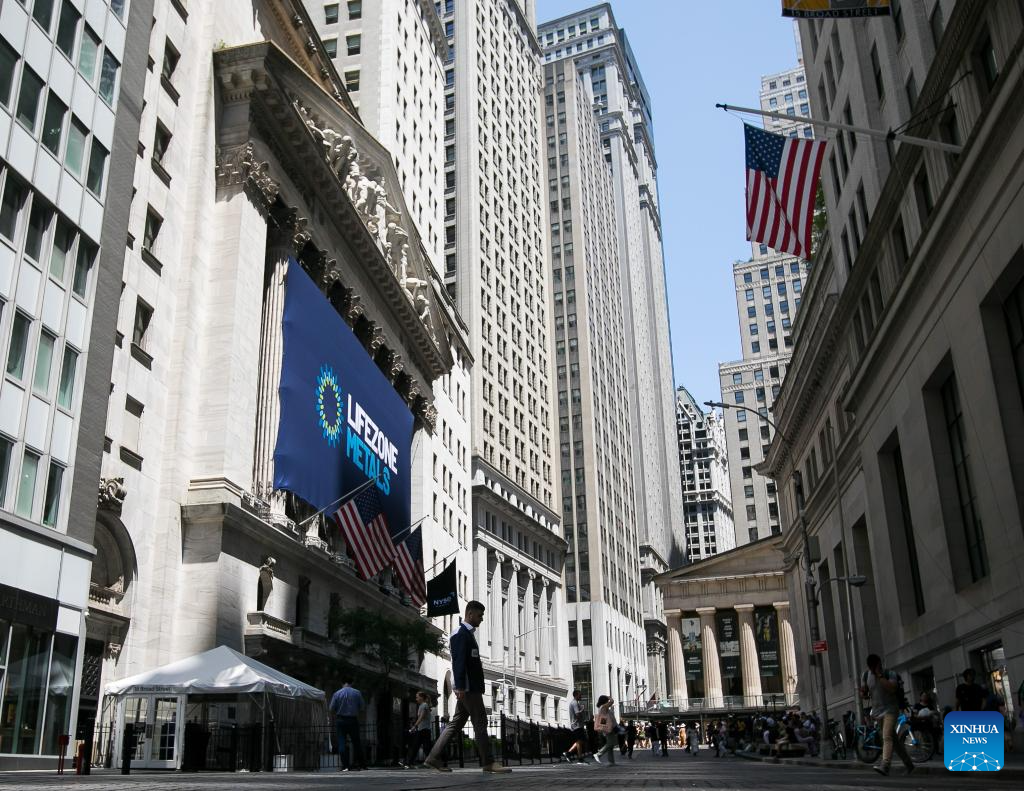
Pedestrains walk past the building of the New York Stock Exchange (NYSE) in New York, the United States, on July 6, 2023. U.S. stocks ended lower on Thursday as strong private hiring data fueled bets the Federal Reserve will have to take a more aggressive approach to tame inflation, which sent U.S. Treasury yields higher and weighed on equity markets. The Dow Jones Industrial Average fell 366.38 points, or 1.07 percent, to 33,922.26. The S&P 500 lost 35.23 points, or 0.79 percent, to 4,411.59. The Nasdaq Composite Index declined 112.61 points, or 0.82 percent, to 13,679.04. (Photo by Michael Nagle/Xinhua)
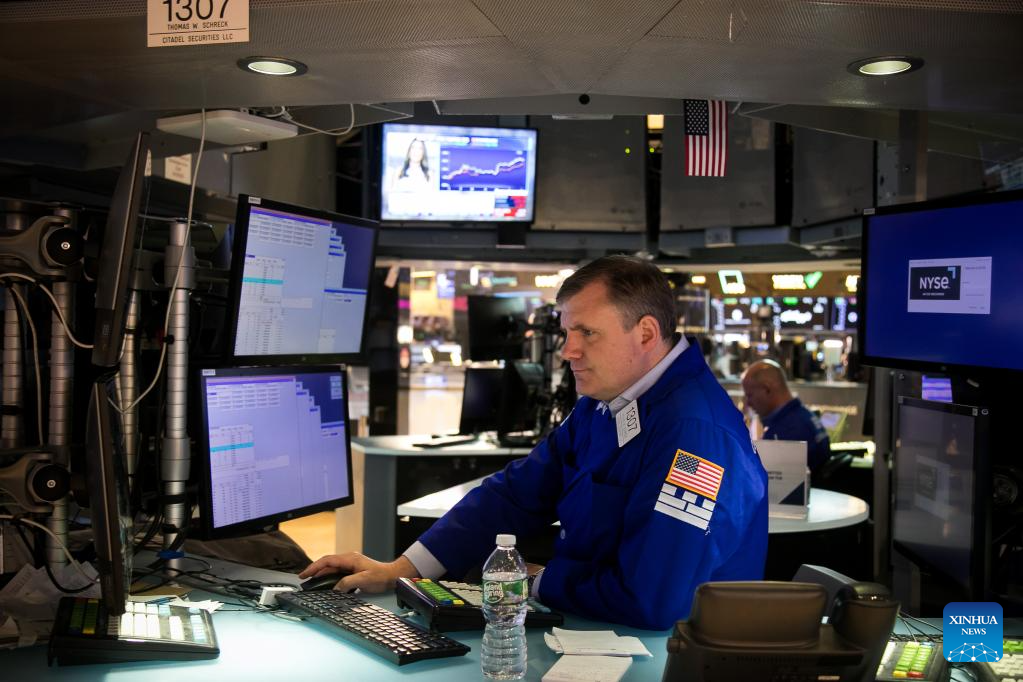
A trader works on the trading floor of the New York Stock Exchange (NYSE) in New York, the United States, on July 6, 2023. U.S. stocks ended lower on Thursday as strong private hiring data fueled bets the Federal Reserve will have to take a more aggressive approach to tame inflation, which sent U.S. Treasury yields higher and weighed on equity markets. The Dow Jones Industrial Average fell 366.38 points, or 1.07 percent, to 33,922.26. The S&P 500 lost 35.23 points, or 0.79 percent, to 4,411.59. The Nasdaq Composite Index declined 112.61 points, or 0.82 percent, to 13,679.04. (Photo by Michael Nagle/Xinhua)
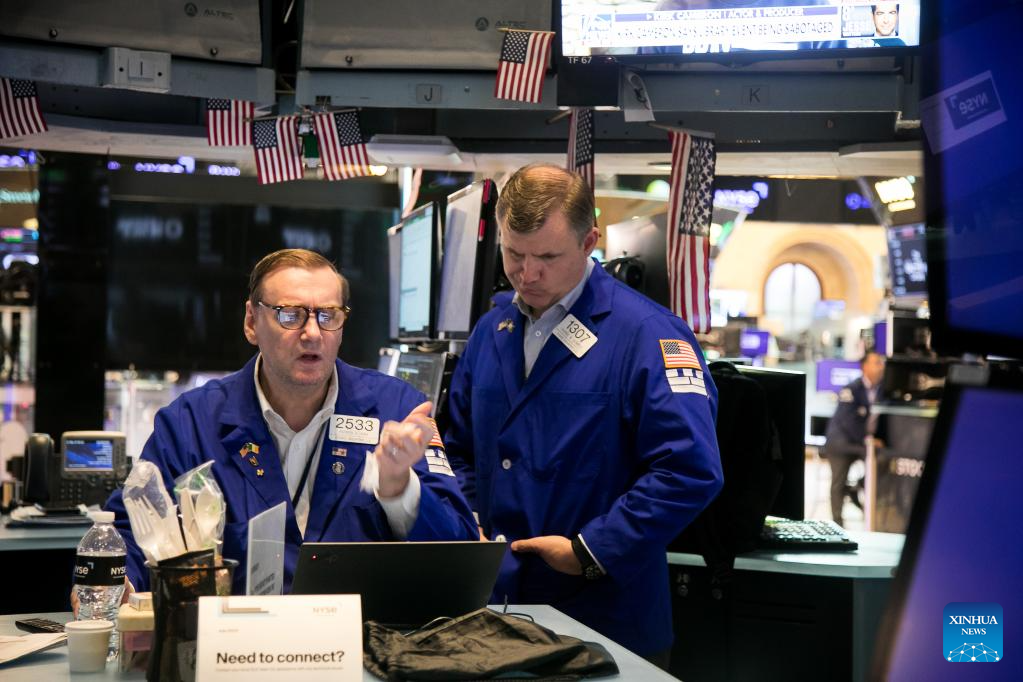
Traders work on the trading floor of the New York Stock Exchange (NYSE) in New York, the United States, on July 6, 2023. U.S. stocks ended lower on Thursday as strong private hiring data fueled bets the Federal Reserve will have to take a more aggressive approach to tame inflation, which sent U.S. Treasury yields higher and weighed on equity markets. The Dow Jones Industrial Average fell 366.38 points, or 1.07 percent, to 33,922.26. The S&P 500 lost 35.23 points, or 0.79 percent, to 4,411.59. The Nasdaq Composite Index declined 112.61 points, or 0.82 percent, to 13,679.04. (Photo by Michael Nagle/Xinhua)
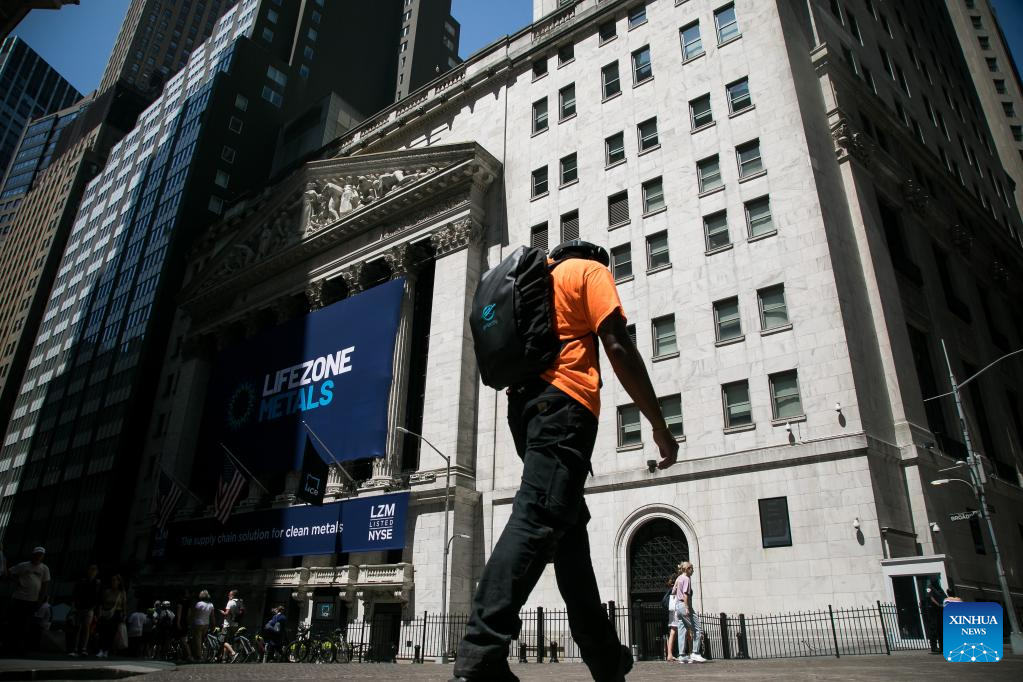
Pedestrains walk past the building of the New York Stock Exchange (NYSE) in New York, the United States, on July 6, 2023. U.S. stocks ended lower on Thursday as strong private hiring data fueled bets the Federal Reserve will have to take a more aggressive approach to tame inflation, which sent U.S. Treasury yields higher and weighed on equity markets. The Dow Jones Industrial Average fell 366.38 points, or 1.07 percent, to 33,922.26. The S&P 500 lost 35.23 points, or 0.79 percent, to 4,411.59. The Nasdaq Composite Index declined 112.61 points, or 0.82 percent, to 13,679.04. (Photo by Michael Nagle/Xinhua)



